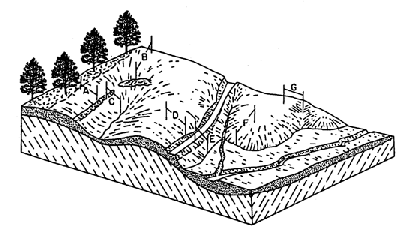1. Soil Degradation
Modelling soil erosion
Knowing where erosion is most likely to happen and being able to make estimates of erosion risk and its intensity in the future, is very important. In order to make such estimates, we need to use quantitative models, where each of the major factors that contributes to erosion, is expressed in numbers and the combination of those factors gives a numerical output that represents the hazard level for erosion.
One of such models is the Universal Soil Loss Equation (USLE) (Wischmeier and Smith, 1978) and its revised version (RUSLE) (Renard et. al., 1997). These models combine factors such as rain erosivity (how much erosive rain is), soil erodibility (how easily soil is eroded), the slope length and gradient of the surface (how steep and how long the slope is), the effect of present vegetation and the impact of human support practices in preventing erosion, to estimate the rate at which soil is being eroded.
Remote sensing can be used to acquire data for some of these factors. The presence of vegetation is quantified as the percentage of the area covered by vegetation. Vegetation cover can be extracted from remotely sensed data, using vegetation indices, most frequently the Normalised Difference Vegetation Index (NDVI) (Tucker, 1979) or the Soil-Adjucted Vegetation Index (SAVI) (Huete, 1988). The slope length and gradient can be calculated using a digital terrain model, which can also be calculated from remotely sensed data, using either pairs of images of the same area taken at a different view angle, or from radar data (see the 3D models tutorial for more information on how these are calculated). In many cases, vegetation cover and surface slope and elevation are the only parameters used, mainly because rain erosivity and soil erodibility are more difficult to calculate and quantify.
Frequently, the study of soil erosion covers a large area, where the rate of erosion varies. In order to calculate the rate or the risk of erosion over a large area, a GIS is employed.

